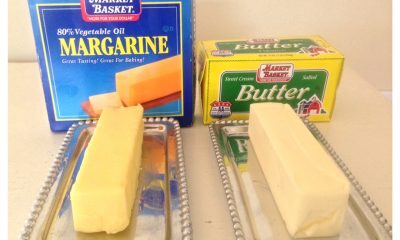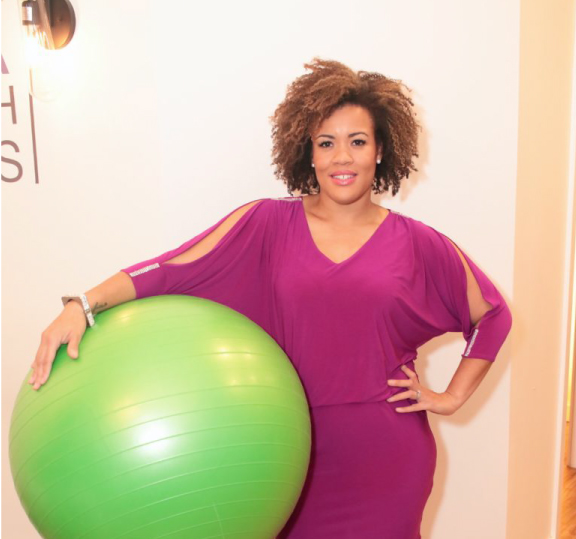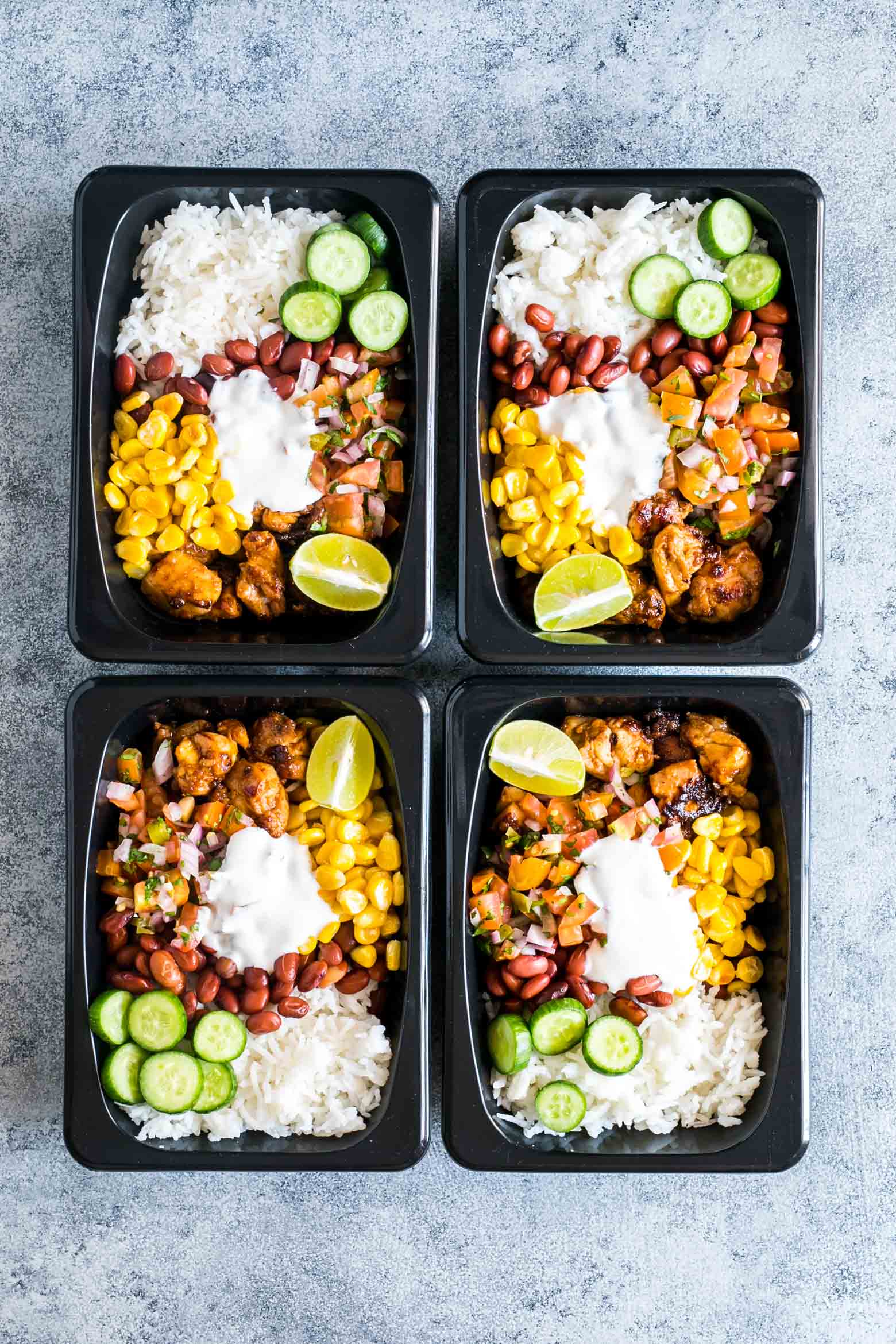
A massive amount of nutrition misinformation exists on the internet.
Some of it is based on poor research or incomplete evidence, while other information may simply be outdated.
The professionals themselves may even tell you things that seem to directly contradict something you read the other day.
A good example of a subject no one seems to agree upon are the health effects of butter and margarine.
This article compares the two, looking at both sides of the debate.
What Are Butter and Margarine?
Butter is a traditional dietary staple made by churning cream.
It’s mainly used as a frying fat, spread or component of sauces, cakes and pastries.
As a concentrated source of milk fat, it’s mostly composed of saturated fat.
Because of studies associating a high intake of saturated fat with an increased risk of heart disease, public health authorities started recommending that people limit their consumption of butter in the 1970s.
Margarine is a processed food that is designed to taste and look similar to butter. It is often recommended as a heart-healthy replacement.
Modern types of margarine are made from vegetable oils, which contain polyunsaturated fats that can lower the “bad” LDL cholesterol when used instead of saturated fat.
Since vegetable oils are liquid at room temperature, food scientists change their chemical structure to make them solid like butter.
For the past few decades, a process known as hydrogenation has been used to harden the vegetable oils in margarine.
Hydrogenation increases the oil’s saturated fat content, but unhealthy trans fats are formed as a side product (1).
A more recent process called interesterification achieves similar results without forming any trans fats (2).
In addition to hydrogenated or interesterified vegetable oils, modern margarine may contain several food additives, including emulsifiers and colorants.
Put simply, modern margarine is a highly processed food product made from vegetable oils, while butter is basically concentrated dairy fat.
SUMMARYButter is a dairy product made by churning cream. Conversely, margarine is a product designed to imitate butter. While butter is mainly composed of dairy fat, margarine is typically produced from vegetable oils.
Health Benefits of Butter
Butter may contain several nutrients not found in many other foods.
For example, butter from grass-fed cows may provide some vitamin K2, which has been associated with improved bone health (3, 4).
In fact, butter from grass-fed cows appears to be a better source of many nutrients than butter from cows fed grains.
Grass-Fed Butter is Nutritious
The health effects of butter largely depend on the diet of the cows it came from.
Cows eat grass in their natural environment, but in many countries, their menu is largely based on grain-based feeds.
Butter from grass-fed cows is much more nutritious. It contains more:
- Vitamin K2: This little known vitamin may help prevent many serious diseases, including cancer, osteoporosis and heart disease (5, 6, 7).
- Conjugated Linoleic Acid (CLA): Studies suggest that this fatty acid can have anti-cancer properties and help lower your body fat percentage (8, 9, 10).
- Butyrate: A short-chain fatty acid found in butter that’s also produced by bacteria in the intestine. It can fight inflammation, improve digestive health and may help prevent weight gain (11, 12, 13).
- Omega-3: Grass-fed butter has less omega-6 and more omega-3, which is important because most people are already eating way too much omega-6 fat (14).
Nonetheless, butter is generally consumed in small amounts, and its contribution to the total dietary intake of these nutrients is low.
SUMMARYButter from grass-fed cows contains much greater amounts of heart-healthy nutrients than butter from grain-fed cows.
Risks of Eating Butter
Some experts are worried about the large amounts of saturated fat and cholesterol in butter and advise people to limit their intake.
High in Saturated Fat
For decades, butter has been demonized for its high saturated fat content.
It’s composed of around 50% saturated fat, while the rest is mainly water and unsaturated fat.
Observational studies investigating the association between saturated fat and heart disease have provided mixed results (1, 15, 16, 17, 18).
A recent review of studies concluded that eating less saturated fat is linked to a 17% reduced risk of heart disease when it’s replaced with polyunsaturated fat (19).
Conversely, switching saturated fat out for carbs or protein appears to have no effects (19).
As a result, some experts doubt that saturated fat intake is really a cause for concern. Others are still convinced that excessive saturated fat intake is a risk factor for heart disease (20).
In fact, health authorities have advised people to limit their saturated fat intake for decades.
Proponents of this popular opinion often point to studies showing that saturated fat increases levels of “bad” LDL cholesterol.
While it’s true that saturated fat promotes higher levels of LDL cholesterol, the story is a bit more complex (21).
Interestingly, some scientists believe that eating saturated fat may actually have some benefits, including improving the blood lipid profile.
It may raise “good” HDL cholesterol and change LDL cholesterol particle size from small and dense to large, which is considered more benign (22, 23, 24).
No strong evidence supports claims that a high intake of butter or other dietary sources of saturated fat are directly responsible for heart disease (25).
However, more high-quality research is needed before scientists can fully understand saturated fat metabolism and its relevance to heart health.
SUMMARYHigh intake of saturated fat has been linked to an increased risk of heart disease, but the evidence is inconsistent. The issue is one of the most controversial in nutrition science.
High in Cholesterol
Butter is also high in cholesterol.
A high intake of cholesterol was once thought to be a major risk factor for heart disease.
This concern was based on studies showing that high blood levels of cholesterol were associated with an increased risk of heart disease (26).
However, it’s now clear that getting moderate amounts of cholesterol from the diet doesn’t raise its blood levels in most people. The body compensates by producing less.
Normally, this keeps its blood levels in the normal range, although a very high intake may still cause a moderate rise in blood cholesterol levels (27, 28, 29).
Public health authorities have advocated low-cholesterol diets for decades.
These guidelines especially apply to people with familial hypercholesterolemia, a genetic condition that causes abnormally high blood cholesterol levels (30).
Nevertheless, dietary strategies seem to have a limited effect in this group (31).
Scientists continue to debate the role of dietary cholesterol in heart disease, but the concerns have been decreasing in recent years (29, 32).
SUMMARYButter is high in cholesterol. However, it has limited effects on blood cholesterol levels in most people.
Health Benefits of Margarine
The health benefits of margarine depend on what kind of vegetable oils it contains and how it is processed.
May Be High in Polyunsaturated Fat
Most types of margarine are high in polyunsaturated fat. The exact amount depends on what vegetable oils were used to produce it.
For example, soybean oil-based margarine may contain approximately 20% polyunsaturated fat (33).
Polyunsaturated fat is generally considered healthy. It may even have benefits for heart health when compared to saturated fat.
Case in point, replacing saturated fat with polyunsaturated fat has been associated with a 17% reduced risk of heart problems, but no significant effect on the risk of death from heart disease (34, 35).
SUMMARYMargarine is often rich in polyunsaturated fat. Studies show that eating polyunsaturated fat instead of saturated fat may reduce the risk of heart problems.
May Contain Plant Sterols and Stanols
Some margarines are enriched with phytosterols or stanols. Vegetable oils are also naturally rich in these compounds.
Phytosterol-enriched margarines lower total and “bad” LDL cholesterol, at least in the short term, but they may also decrease ”good” HDL cholesterol (36, 37).
However, most studies haven’t detected a significant association between total phytosterol intake and heart disease risk (38, 39).
It’s important to stress the difference between risk factors and hard outcomes.
SUMMARYVegetable oil-based margarine is often rich in phytosterols. While phytosterols may reduce the levels of LDL cholesterol, they don’t seem to affect heart disease risk.
Risks of Eating Margarine
Although margarine may contain some heart-friendly nutrients, it often contains trans fat, which has been associated with an increased risk of heart disease and other chronic health issues (1).
May Be High in Trans Fats
Vegetable oils are not solid at room temperature like butter.
To make them solid for use in margarine, food scientists chemically change their structure using a process known as hydrogenation.
This involves exposing the oils to high heat, high pressure, hydrogen gas and a metal catalyst.
Hydrogenation changes some of the unsaturated fat into saturated fat, which is solid at room temperature, and also increases the product’s shelf life.
Unfortunately, trans fat is formed as a side product. A high intake of industrial trans fats has been linked to an increased risk of chronic disease (1).
For this reason, health authorities strongly advise people to limit their consumption of it.
Additionally, the FDA is implementing a ban on trans fat in all processed foods, although food producers can apply for an exception.
As a result, many food producers have started using a new technique to harden the vegetable oils in margarine.
This method is called interesterification. It replaces some of the unsaturated fats in the oil with saturated fat (2).
Interesterified vegetable oils are considered healthier than hydrogenated oils because they contain no trans fats.
If you prefer margarine over butter, try to select trans-fat-free varieties. If it says “hydrogenated” anywhere on the ingredients list, avoid it.
SUMMARYMany margarines are high in trans fat, which is linked to an increased risk of chronic disease. However, because of negative publicity and new laws, trans-fat-free margarines are becoming increasingly common.
May Be High in Omega-6 Fat
Many types of polyunsaturated fats exist.
They are often divided into categories based on their chemical structure. Two of the most common are omega-3 and omega-6 fats.
Omega-3 fats are considered anti-inflammatory, meaning they act against inflammation. Conversely, eating too much omega-6 fat may promote chronic inflammation.
Based on ancestral diets, the optimal ratio of omega-6 to omega-3 is estimated to be around 1:1.
If this ratio has any health relevance, people are eating far too much omega-6 fat today. In fact, the ratio is estimated to be as high as 20:1 in developed countries (40).
Observational studies have linked a high intake of omega-6 fat to an increased risk of obesity and chronic diseases, such as heart disease and inflammatory bowel disease (41).
However, analyses of controlled studies conclude that linoleic acid — the most common omega-6 fat — doesn’t affect blood levels of inflammatory markers (42, 43).
Because of this inconsistency, it’s unclear whether a high intake of omega-6 fats is really a cause for concern. More research is needed.
Vegetable oils that are especially high in omega-6 fat include sunflower, corn, soybean and cottonseed oils.
If you are worried about eating too much omega-6 fat, avoid eating margarine containing these oils.
SUMMARYMargarine is often very high in polyunsaturated omega-6 fatty acids. Some scientists believe excessive omega-6 intake may promote inflammation, but controlled studies do not support this theory.
The Bottom Line
Butter and margarine look similar and are used for the same purpose in the kitchen.
However, their nutritional profiles differ. While butter is high in saturated fat, margarine is rich in unsaturated fat and sometimes trans fat.
The health effects of saturated fat are highly controversial, and its role in heart disease has been downplayed in recent years.
Conversely, scientists agree that trans fats, which are found in some margarines, raise the risk of chronic disease. For this reason, trans-fat-free margarines are becoming increasingly common.
If you prefer margarine over butter, make sure to choose trans-fat-free brands and select products made with healthy oils, such as olive oil.
If butter is your favorite, consider buying products made from grass-fed cow’s milk.
In the end, there is no clear winner, but I personally prefer foods that are less processed, like butter.
Whatever you choose, consume these products in moderation.
SOURCE

















 Sugar, that sweet, crystalline white carbohydrate that is essential to our bodies regular function, but also highly detrimental to our health if consumed in excess or in its refined state. In normal energy production processes, the human body uses carbohydrates, sugars, and starches, to fuel normal metabolic processes on a cellular level. However, intake of highly processed and refined sugars has been linked to increased risk of developing adverse health conditions. Refined sugar usually comes from sugar cane or sugar beets that are processed into a form known as sucrose, a combination of glucose and fructose.
Sugar, that sweet, crystalline white carbohydrate that is essential to our bodies regular function, but also highly detrimental to our health if consumed in excess or in its refined state. In normal energy production processes, the human body uses carbohydrates, sugars, and starches, to fuel normal metabolic processes on a cellular level. However, intake of highly processed and refined sugars has been linked to increased risk of developing adverse health conditions. Refined sugar usually comes from sugar cane or sugar beets that are processed into a form known as sucrose, a combination of glucose and fructose.





 If you’ve ever sought advice for losing weight, you’ve probably been told to meal prep by everybody from your trainer, your doctor, and maybe even your pastor. And we’re not here to bust any myths. If you want to step your nutrition game up, lose weight, gain weight, or just be consistently healthy, meal prep is king.
If you’ve ever sought advice for losing weight, you’ve probably been told to meal prep by everybody from your trainer, your doctor, and maybe even your pastor. And we’re not here to bust any myths. If you want to step your nutrition game up, lose weight, gain weight, or just be consistently healthy, meal prep is king.






